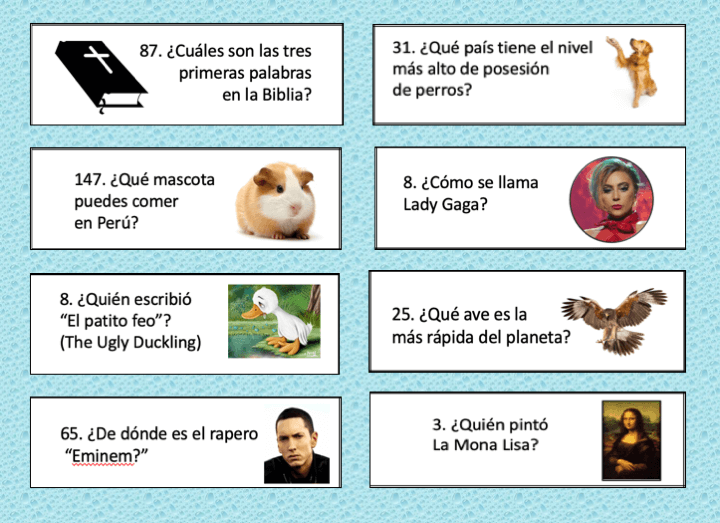6 Tested and Effective Strategies for Differentiating in World Language
Are you wondering how to differentiate in your world language classroom? How to tailor your instruction to meet the diverse learning needs of your students?
It’s reasonable to ask a teacher who has 20-25 students a day to differentiate.
But world language teachers in secondary education have from 100 – 150 students. Requiring us to write different lesson plans for the variety of skill levels in our classes is asking us to put our mental health in jeopardy.
OK, we’ll do that. After we create resources for comprehensible input, write lesson plans aligned with the ACTFL standards, grade papers (essays are murder!), arrange for modifications for our IEP and 504 students, call parents about misbehavior or academic fraud (sweating every minute), make copies (if the machines are working), attend lunch tutorial session (no time to eat), fill in for an absent teacher, attend PLC, department, and PD meetings, attend NIDs, fill out referral and other various forms, fix the technical issue that ruined our lesson today…
THEN we’ll write an extra lesson to accommodate the students who had a non-Spanish or French-speaking substitute the previous year and the misplaced native students who are bored to tears.
OK, now that we’ve commiserated, I have good news. There ARE ways to differentiate in world language, to challenge the advanced students, support the struggling ones, and provide equal access to student learning.
Below is a variety of strategies for effective differentiation in a foreign language classoom:
HERE ARE SIX WAYS TO DO IT:
1. Have a System in Place That Rewards Fast Finishers.
It IS possible to maintain high expectations and still meet the needs of students at different levels of understanding. If you don’t challenge the more advanced students, you may have to deal with classroom management issues. Sometimes the rabble-rousers are just bored. I used Minimaratón (Spanish Trivial Pursuit) for my fast finishers. I wrote the question on the board in Spanish, but you can also give the students the question card.
When students have finished the assigned task, they are allowed to ask for their phones (which are safely hanging in the phone pouches) so they can use www.wordreference.com They raise their hand and ask, “¿Puedo contestar Minimaratón?” The first person to answer correctly gets a prize. OK, I admit it; I gave them chocolate bars.
I started the year by giving large bars. After the Minimaratón culture was embedded into the class routine, usually a few weeks, I gave out smaller bars and students were just as motivated to figure out the question and find the answers.

2. Give students choices of reading material.
In my advanced classes, if I had handed out, “Cajas de carton” I would have had to deal with a few tearful, discouraged students whose vocabulary was not sufficient to comprehend the story. So, I gave them the choice between two novels, one at advanced or the other at intermediate level. Students self-identified honestly and chose the book appropriate to their level.
3. Give students choices of homework.
How to differentiate with homework? You can accommodate different learning styles by providing choices of homework. Differentiation applies not only to skill level, but also to interest. If students are more interested in one topic than another or prefer one method of presentation over another, they will apply themselves more diligently.
For projects, I gave students several options:
Write about a place in a Spanish-speaking country or a famous Hispanic.
Create a Prezzi, PowerPoint, video, or poster presentation.
Use real photos or famous people, etc.
For daily open-ended homework, I sometimes gave students options:
Choose one of the following activities:
Write the vocabulary two times in French and once in English or draw the vocabulary and write it once in French.
Call me on Google Voice or record a video.
Talk to someone in Boomalang, Talk Abroad, or to a native speaker friend/parent.
And here’s a new idea I always meant to do but never did.
How to differentiate with choice: Create a list of homework assignments related to what you will cover during the year and have it ready.
Here is how Kara Jacobs did it in her Spanish Three class: Homework Choice
Here is Musicuentos’ Homework Choice List from her Blog Post.
4. Provide Stations
Incorporate station activities into your lesson planning. This will take a while to create, but once created, can be used for years. Look at the topic or concept you want to teach, for example, describing people. Set up four to six stations with different activities. Assign students according to readiness level or have them self-assign.
For example, in one station, students can read about famous people. In another, they can listen to an audio about famous people, while reading a script. In another, they can watch a video describing people. In another, they can write a description of a person they know (for higher-level students who are ready to produce.)
EIGHT STATIONS ACTIVITY
In the following activity, students speak the target language all period long, or even during two periods with the higher-performing students asking the questions and the middle-to-lower-performing students answering them. Students work in different groups: Eight-Stations Activity for the Preterite Tense.
There are Eight-Stations Activities for Spanish One (present tense), for Spanish Four (subjunctive) and for French Two (passé compose) in my store.
And here is a FREE 8-Stations Activity for Spanish Three (future tense.)
5. Assign different tasks that allow students to go at their own pace.
For example, EdPuzzle videos, Digital Mystery Pictures, and Google Forms Activities provide practice while allowing each student or groups of students to proceed at their own speed. They can even go back to correct errors, as these are all self-correcting activities
6. Assign Paired Activities.
Every differentiated classroom should have paired and group tasks. It’s just more fun to learn with a partner, and during paired activities, student engagement is high, and the effective filter low (lower stress). While there are always individual students who prefer to work alone, they are the exceptions. The main benefit, however, is that students help each other, each student’s strength bolstering his partner’s weakness.
One of the best paired activities for world language are dice games because it is almost impossible for students to make mistakes, so they can have fun without fear and the activities provide built-in comprehensible input. For example, this paired dice game works well to reinforce the Spanish direct object pronouns.
I hope this post gave you a few useful ideas for how to differentiate in your Spanish and French classes while creating a supportive learning environment for all your students.
Would you like to get teaching tips and freebies in your email? If so, click on Best PowerPoints for Spanish and French and scroll to the bottom. For signing up you get a FREE 122-slide PowerPoint on regular verbs and infinitives.
Are you following my store? Be the first to see new products and updates on existing products. Click on MY STORE to follow me.




I do agree with everything that you have said. Usually, all students don’t have a choice to learn what they want. I think that it is wrong.